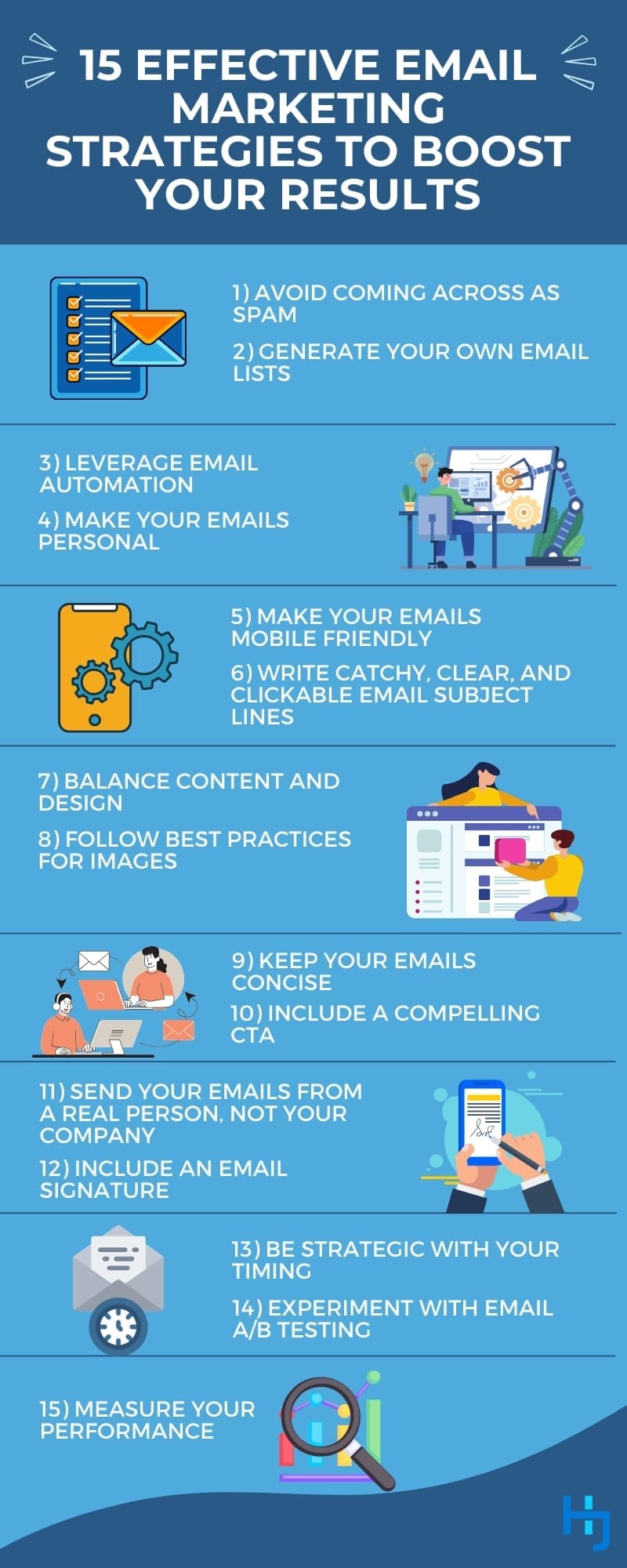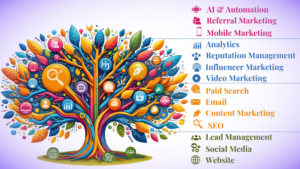 Developing a strong email marketing strategy is one of the best things you can do to stimulate business growth. With 99 percent of people checking email at least once daily, per OptinMonster, it’s one of the surest ways to reach your audience. The ROI is considerable too. Brands get $36 back for each $1 spent on email marketing, according to Litmus.
Developing a strong email marketing strategy is one of the best things you can do to stimulate business growth. With 99 percent of people checking email at least once daily, per OptinMonster, it’s one of the surest ways to reach your audience. The ROI is considerable too. Brands get $36 back for each $1 spent on email marketing, according to Litmus.
However, it’s easy to make missteps that reduce the effectiveness of your campaigns. Give me a few minutes, and I’ll walk you through how to create the best email marketing strategy for your business, avoid common errors, and create high-performing campaigns consistently.
1. Avoid Coming Across as Spam

Put yourself in the mind of the email service provider and the consumer for just a moment. Roughly 45 percent of emails sent and received are spam messages, according to MailModo. Consumers understandably don’t want these messages invading their inboxes, so email service providers put up roadblocks to stop spam in order to boost customer satisfaction.
That means email service providers monitor senders very closely. They look for signals that your email might be spam and rate you as a sender. If an individual email looks like spam to the email service provider, it may forward the email to the recipient’s spam or junk folder. Sometimes it will vaporize emails before they even reach the recipient. If the sender starts to look like a spammer based on its habits, the email service provider may blacklist the sender altogether. That means it stops letting your emails go through.
You might notice you have an email deliverability problem like this if your open rate suddenly tanks, but it’s not something your email marketing platform will report to you. If it persists and you wind up blacklisted, it’s incredibly difficult, if not impossible, to get whitelisted. It’s often easier to start over with a new domain name than it is to correct a bad sender reputation.
Anti-Spam Best Practices
While PECR for those with UK audiences, CASL for those with Canadian audiences, CAN-SPAM compliance for those with US audiences, and other laws for various jurisdictions may apply too, maintaining a good sender reputation should be a priority for everyone. In addition to following the email marketing strategies covered throughout this page, you can help ensure you don’t look like a spammer to email providers by following the guidelines below.
Only Send Emails That Are Relevant to the Reader
Email providers may pick up on low open rates and think you’re sending spam.
Use a Custom Domain
Spammers often use accounts from free email providers like Hotmail and Gmail because they expect to get caught and need to switch often.
Verify Your Domain
Performed in your email marketing platform, domain authentication provides email providers with proof that the owner of a specific domain is the one using that domain name to send emails, rather than a hacker or spoofer.
Keep Your Email Lists Clean
In addition to catching low open rates, email providers will pick up on high email bounce rates and may think you’re sending spam if you’re sending to an outdated or unkempt list.
Avoid Spam Words in Subject Lines and Preview Text
Words like “free” and “sale” will often trigger spam filters. A list of nearly 400 spam words is available through HubSpot.
Include Essential Info in Your Footer
Senders should always include a physical address and provide a clear way to unsubscribe in every email.
Be Mindful of Free or Cheap Email Marketing Tools
Just like internet users can be identified with an IP address, email senders can be too. Email marketing platforms typically use shared blocks of IP addresses, so your messages will originate from the same place as other businesses. If any of those senders are presently or previously engaged in spamming or spam-like practices, the IP will develop a bad reputation. This issue rarely happens with paid email marketing tools, but it’s somewhat common when you use a free tool, or your platform offers a free tier.
Ramp Up Slowly
Start mailing to a small group of engaged contacts and slowly build up to increase your sender reputation.
Avoid Large Swings in Volume
Businesses that engage in ethical practices will grow their contact list over time, so send volume will increase slowly too. Email service providers may pick up on a large volume shift and assume you’re spamming.
2. Generate Your Own Email Lists
It may be tempting to purchase email lists, especially if you’re just starting out and don’t have a database full of contacts. However, these lists are often low-quality, and many addresses will no longer be valid. In addition, because the contacts don’t recognize you, they’re less likely to open emails.
“Spam traps” may also be mixed in. These are decoy email addresses that have never been valid that belong to email service providers. When a message is sent to one, the provider knows that the sender is transmitting unsolicited messages. It negatively impacts the sender’s reputation and may result in being blacklisted.
If your list is light and you want more addresses, create more top-of-funnel content and encourage prospective clients to sign up for your newsletter.
3. Leverage Email Automation
Countless email marketing processes can be automated. For instance, you can run automatic drip and nurturing campaigns. Most email marketing platforms will allow you to automate segmentation too. Even seemingly minor things, like setting up templates to streamline your content creation, will really add up.
4. Make Your Emails Personal
People respond to content that creates some type of personal connection. Four in five say they’re more likely to purchase from a brand that provides personalized experiences, Forbes research shows. Conversely, two in five say they’re annoyed when content isn’t personalized.
Segment Your Email Subscribers
Segmentation allows you to tailor emails to the needs of the reader. Segment your lists in whatever way makes the most sense for your business. Consider breaking them up by:
- Customer Journey Stage
- Product or Service Interest
- Industry
- Company
- Job Title
- Region
Personalization
Most email marketing tools allow for some level of personalization. For instance, you may be able to add a placeholder field for the recipient’s name, company name, or region in subject lines, body copy, or on buttons. These minor tweaks often increase engagement, though running tests to see how your audience responds is always a good idea.
Dynamic Content
Some marketing platforms provide a much deeper level of personalization, called “dynamic content.” Dynamic content looks at data before deciding what to present to a reader. For example, the system might look at the reader’s behaviors, interests, preferences, or other data before serving something up.
For instance, a sales email might offer a list of potential add-ons to a product the customer already has. If that feature is built with dynamic content, add-ons the client already purchased can be omitted. Or, let’s say the company is running a special and wants to showcase only one add-on per email. Dynamic content can be used to showcase whichever add-on the reader has engaged with the most, as demonstrated by email clicks or website visits. This is a tactic e-commerce stores often use when you leave something in your cart and don’t check out.
Dynamic content is so powerful that businesses that leverage it generate twice as much ROI as those that don’t, per Litmus research.
5. Make Your Emails Mobile Friendly
Four in five people regularly use their smartphone to check their email, Campaign Monitor data shows. Because of this, templates should be responsive and adapt to screens of all sizes or be built in a single-column layout. Additional techniques, such as leaving extra space between clickable elements and bumping the call-to-action (CTA) up to the top of an email, will also boost engagement.
It’s worth noting that there will be differences in how email platforms display the same message. You’ll also catch differences in the way a single platform displays content across devices and software types. For instance, how Gmail displays an email in Chrome on a desktop computer will not be the same way it displays the same content in the Gmail app on an Android phone or how it displays on the Safari browser on your iPhone. Because of this, investing in a tool like Litmus allows you to preview emails across platforms, browsers, and devices before sending is helpful.
6. Write Catchy, Clear, and Clickable Email Subject Lines
The email subject line is one of the first things people see and is the sole determining factor in whether an email gets opened or deleted 64 percent of the time, according to HubSpot research.
Track What Works
Monitor your email open rates to see if there are commonalities in subject lines between the top performers. Try to use a similar approach going forward if you find any.
Keep it Short and Concise
Most desktop systems don’t display more than the first 50 or 60 characters of a subject line, while some mobile platforms cut the text off at 25 or 30 characters. Be as brief as possible and place the most important concepts closer to the front of the subject line.
Personalize It
Explore ways to personalize your email subject lines and experiment with a few to see what works best.
Create the Right Expectation
Readers should have some idea of what they’ll find when they open an email for two main reasons. First, they’ll often ignore or delete messages with vague subjects. Second, they’ll lose faith in your emails and stop opening subsequent ones if they feel like your subject lines are misleading them.
Include Power Words
Words like “you,” “achieve,” “success,” and “easy” create an emotional response in the reader that increases the odds that they’ll open your message. Try using a tool like the CoSchedule Subject Line Tester to improve your use of power words and strengthen your email subject lines as a whole.
Create a Sense of Urgency or Importance When Appropriate
While you want to give readers a reason to open your message and engage with it right away, not everything is truly urgent. “When everything is a priority, nothing is a priority,” as business performance improvement expert Karen Martin says. The same rule applies to your emails. Let them know if a deadline is approaching or if an opportunity is limited but don’t invent urgency, or they’ll lose trust and not believe when something truly is.
Use Numbers
Which sounds more compelling:
- Save Money or Save $20?
- Let’s Meet Today or Let’s Meet for 5 Minutes Today?
- Easy Ways to Save Time or 6 Easy Ways to Save Time?
- Join Us Today or Join 230 of Your Peers Today?
- Sale Ends Soon or 2 Hours Left to Save?
You get the picture. The option with the number almost always sounds more compelling and will increase your open rate.
Don’t Scream
You know how some people put EVERYTHING IN CAPS to show how IMPORTANT it all is? Those are often the same people who feel the need to put exclamation points, or worse, multiple exclamation points, at the end of everything!!! This is the written equivalent of yelling at your reader. People don’t enjoy it, and it often triggers spam filters. Use title case for your email subject lines instead, and use punctuation sparingly, if at all.
Consider Emojis
Emojis can often increase open rates, but they’re not appropriate for every email, audience, or business. If it’s appropriate for your brand, experiment with emojis to see how they impact opens. Use them more often if you see improvement.
Pair it with Strong Preview Text
Preview text appears below the subject line before a reader opens your email. If your email marketing program doesn’t provide a way to add preview text or you don’t use it, readers usually see the stock text at the start of your email, like “View in Browser,” or the opening lines of your message. That’s not exactly compelling. Use your preview text to expand on your subject line and give readers more reasons to open it.
7. Balance Content and Design
Best practice for balancing content and design in emails is to follow the 60/40 rule. Ensure no less than 60 percent of your email content is text, and no more than 40 percent is images. There are two big reasons to strive for this with every send. First, many email service providers assume the message is spam if it’s too image heavy. Secondly, certain email platforms don’t display images by default. If your email relies heavily on images to convey your point, some readers may never know the purpose of your message.
8. Follow Best Practices for Images
In addition to ensuring your email content is balanced, there are a few more best practices for images that can boost engagement.
Avoid Background Images
Not all email clients display background images. Because every email program may interpret the code differently and display the image differently, results often leave a lot to be desired or even slow down the loading process so much that many readers leave before the email loads. It’s generally best to avoid background images for these reasons.
Add Alt Text to Your Images
Alt image text is used to describe what’s happening in an image. They’re important for accessibility because people with visual impairment and those with certain learning disabilities will often use tools that read the text out loud to them. If no alt image tag is present or you don’t fill in the box in your email marketing program when adding the image, screen reader users don’t get the information contained in the image.
This text is also often what displays in place of an image when an email client doesn’t display images, so readers using platforms like Microsoft Outlook will see these words instead of your images until they specifically choose to download the images.
It’s also worth noting that email clients look at alt image tags when deciding if an email is spam. So your message is less likely to be flagged as spam if you include them.
Hyperlink the Images in Your Emails
Consider what the user will expect to find when they click on an image. For instance, your logo should generally direct someone to your website’s homepage. A picture of a product or service should generally take the reader to more information about it. If your image is part of a CTA, clicking it should take the reader to their next step. Even images that are part of your newsletter and relate to your blog should link back to the corresponding post.
Consider Using Gifs
Brands that say they always or often use gifs in email get an average ROI of $37 for each $1 spent, according to Litmus. Conversely, those who never use gifs earn just $18 for each $1 spent. Experiment with ways to use gifs in your messages, but also remember that some email programs won’t display the animation at all. Instead, readers will only see the first frame. There are email clients that display gifs much like a video too. Readers must click a play button to view the animation.
9. Keep Your Emails Concise
Especially with the trend toward mobile, it’s important to keep emails as concise as possible. In this respect, people often quote studies that show 100 or fewer words is best. For instance, emails with the highest response rates come in at 75 or 100 words, according to Boomerang research. The problem here is that Boomerang is a productivity app that helps with one-on-one messages. Of course, these can be very short and still get their point across. The same might even be true for many of your promotional emails.
But, what if your email campaign relates to a webinar and you need to include many details, or you’re sending an email newsletter? You won’t be able to limit yourself to 100 words and still deliver value. In these cases, you can go over the 100-word mark to cover the topic sufficiently but do your best to stay under 400 words if you want the reader to stick around until the end.
10. Include a Compelling CTA
Emails with a single call-to-action get 371 percent more clicks than those with multiple CTAs or no CTA, WordStream research shows. Sales jump 1,617 percent too. The reason for this is simple. Readers are primed to follow the flow you establish for them. They go on autopilot. If you don’t provide them with a next step, their autopilot directs them away from your content. So always give them their next step.
Additionally, make sure your call-to-action buttons stand out. Use a bold, contrasting color that draws eyes to it, and leave empty space around them. This sends the subconscious signal that a button is important and makes it easier to click, which is essential for mobile users working with smaller screens.
Lastly, experiment with the text you use. For example, readers respond to action words like “Go,” “Try,” “Get,” “Reserve,” and “Claim.”
11. Send Your Emails from a Real Person, Not Your Company
Emails sent from an individual versus a corporate entity seem more personal and will likely receive more engagement. Use a real person’s name as the sender, but also ensure readers can tell which company that person is with. Options like “Jane Smith at Widget Co.” or “Amir Amin, Widget Co. CEO” do best, but remember that email programs will clip the name at different points. Gmail, for example, stops at 20 characters. Yahoo sometimes clips names at as few as 14.
12. Include an Email Signature
If you use the technique above, include the individual’s traditional email signature line at the end. It demonstrates authenticity and gives readers a quick way to respond. Plus, it seems more personal, which is helpful if you’re using campaigns to build relationships.
13. Be Strategic with Your Timing
There is no singular best time to send an email, as every industry and audience may behave in slightly different ways. However, Tuesdays and Thursdays tend to be the best day to send messages across the board, OptinMonster research shows. People are also more likely to open messages that are sent during transition times throughout the day. For instance, an email sent at 8 am will likely catch someone checking their messages first thing in the morning, while an email sent at 1 pm will catch them as they get back to work after lunch. You can sometimes catch them right before they leave work and also when they’re commuting home at the end of the day.
Schedule your emails to roll out during these times in the recipient’s time zone to start, then experiment with different times to see if your opens and clicks improve. Go with what works best for your readers.
14. Experiment with Email A/B Testing
Throughout this page, I’ve referenced testing certain things, like subject lines and emojis. To give additional background, the proper term for this process is “A/B testing.” It’s a way to optimize your campaigns for performance over time by making one small change to an email campaign, then sending both the original campaign and the new variant to readers. Each reader only receives one version of the campaign, and the list is randomly split to remove bias.
Many email marketing programs allow you to maximize the value of the campaign you’re sending by allowing you to hold back a portion of the messages and send it after the “winning” variant is determined, while others simply split the full group and send once.
Businesses that leverage A/B testing get an ROI of $42 on email marketing, compared to the $23 their counterparts earn, Litmus data shows.
Email A/B Testing Ideas
You can test just about anything in your email campaigns. Try the following ideas or use them to come up with your own:
- Length of your subject line
- Power words in your subject line
- No emoji vs. emoji in your subject line
- Different emojis in your subject line
- Personalization in your subject line
- Color, shape, or size of your CTA button
- Wording on the CTA button
- Send time or day
- Sender name
- Longer copy vs. shorter copy
15. Measure Your Performance
Your goal may vary from one email campaign to the next, so the person fulfilling your email marketing role should be familiar with a variety of email KPIs and what each means.
Email Marketing KPIs
- Click-Through Rate
- Click-to-Open Rate
- Conversion Rate
- Deliverability Rate
- Forward Rate
- Hard and Soft Bounce Rates
- Inbox Placement Rate (IPR)
- Open Rate
- ROI
- Social Shares
- Spam Reports
- Unsubscribe Rate
Get Help Improving Your Email Marketing Strategy
Email marketing is one of the earlier initiatives that I help businesses kick off when I accept a new project as a digital marketing consultant. It delivers great ROI and doesn’t require a large investment. As you’ve seen throughout this page, though, the results hinge upon the strategy. If your business isn’t getting results from its email marketing efforts or you’re not sure how to fold email marketing into your overall digital marketing strategy, let’s talk. Contact me for a complimentary consultation.




































































